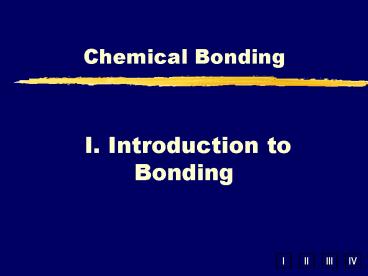Chemical Bonding PowerPoint PPT Presentation
1 / 21
Title: Chemical Bonding
1
I. Introduction toBonding
- Chemical Bonding
2
A. Vocabulary
- Chemical Bond
- attractive force between atoms or ions that binds
them together as a unit
3
B. Types of Bonds
COVALENT
IONIC
e- are transferred from metal to nonmetal
e- are shared between two nonmetals
Bond Formation
Type of Structure
true molecules
crystal lattice
Physical State
liquid or gas
solid
Melting Point
low
high
Solubility in Water
yes
usually not
yes (solution or liquid)
Electrical Conductivity
no
Other Properties
odorous
4
B. Types of Bonds
METALLIC
e- are delocalized among metal atoms
Bond Formation
Type of Structure
electron sea
Physical State
solid
Melting Point
very high
Solubility in Water
no
yes (any form)
Electrical Conductivity
malleable, ductile, lustrous
Other Properties
5
B. Types of Bonds
Ionic Bonding - Crystal Lattice
- Remember Opposites Attract!
RETURN
6
B. Types of Bonds
Covalent Bonding - True Molecules
Diatomic Molecule
RETURN
7
B. Types of Bonds
Metallic Bonding - Electron Sea
RETURN
8
C. Bond Polarity
- Difference in electronegativity determines bond
type. - Above 1.7 ionic
- 0.3-1.7 polar covalent
- 0-0.3 non-polar covalent
9
C. Bond Polarity
- Electronegativity
- Attraction an atom has for a shared pair of
electrons. - higher e-neg atom has a partial negative charge ?
?- - lower e-neg atom has a
- partial positive charge? ?
10
C. Bond Polarity
- Nonpolar Covalent Bond
- e- are shared equally
- usually between identical atoms
- Ex. F2
11
C. Bond Polarity
- Polar Covalent Bond
- e- are shared unequally
- results in partial charges (dipole)
12
C. Bond Polarity
- Nonpolar
- Polar
- Ionic
View Bonding Animations.
13
C. Bond Polarity
- Examples
- Cl2
- HCl
- NaCl
3.0-3.00.0 Nonpolar 3.0-2.10.9 Polar 3.0-0.92.1
Ionic
14
D. Lewis Structures
- Electron Dot Diagrams
- show valence e- as dots
- EX oxygen
O
15
D. Lewis Structures
- Covalent show sharing of e-
- Ionic show transfer of e-
16
D. Lewis Structures
- Covalent show sharing of e-
- Ionic show transfer of e-
17
D. Lewis Structures
- Nonpolar Covalent - no charges
- Polar Covalent - partial charges
18
Steps for Building a Dot Structure
- Ammonia, NH3
- 1. Decide on the central atom never H. Why?
- If there is a choice, the central atom is atom
of lowest affinity for electrons. (Most of the
time, this is the least electronegative
.)Therefore, N is central on this one - 2. Add up the number of valence electrons that
can be used. - H 1 and N 5
- Total (3 x 1) 5
- 8 electrons / 4 pairs
19
Building a Dot Structure
- 3. Form a single bond between the central atom
and each surrounding atom (each bond takes 2
electrons!)
4. Remaining electrons form LONE PAIRS to
complete the octet as needed (or duet in the case
of H).
3 BOND PAIRS and 1 LONE PAIR.
Note that N has a share in 4 pairs (8 electrons),
while H shares 1 pair.
20
Building a Dot Structure
- Check to make sure there are 8 electrons around
each atom except H. H should only have 2
electrons. This includes SHARED pairs.
6. Also, check the number of electrons in your
drawing with the number of electrons from step 2.
If you have more electrons in the drawing than
in step 2, you must make double or triple bonds.
If you have less electrons in the drawing than in
step 2, you made a mistake!
21
Carbon Dioxide, CO2
- 1. Central atom
- 2. Valence electrons
- 3. Form bonds.
C 4 e-O 6 e- X 2 Os 12 e-Total 16 valence
electrons
This leaves 12 electrons (6 pair).
4. Place lone pairs on outer atoms.
5. Check to see that all atoms have 8 electrons
around it except for H, which can have 2.
22
Carbon Dioxide, CO2
C 4 e-O 6 e- X 2 Os 12 e-Total 16 valence
electrons How many are in the drawing?
6. There are too many electrons in our drawing.
We must form DOUBLE BONDS between C and O.
Instead of sharing only 1 pair, a double bond
shares 2 pairs. So one pair is taken away from
each atom and replaced with another bond.
23
Double and even triple bonds are commonly
observed for C, N, P, O, and S
H2CO
SO3
C2F4
24
Now You Try One!Draw Sulfur Dioxide, SO2

